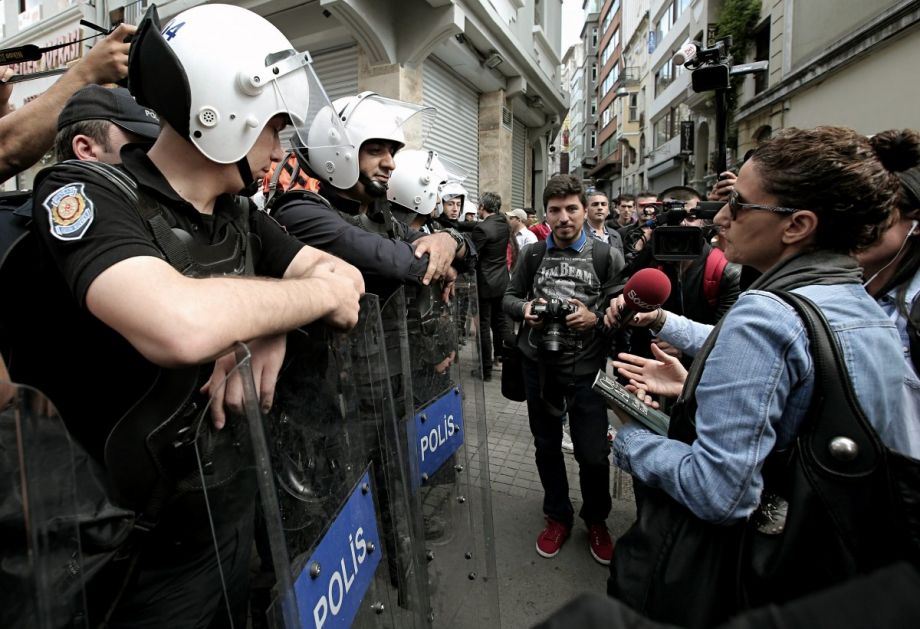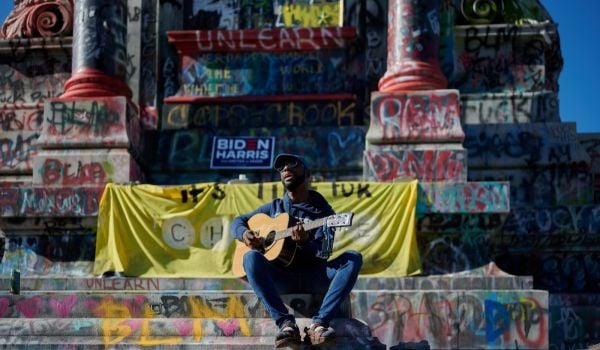Unkempt and rough around the edges, Istanbul’s Gezi Park is not exactly New York’s Central Park, or Chicago’s Millennium Park. It might be more akin to the Alamo in San Antonio: a beloved space in the city center, once fiercely protected while under siege and now a proud public symbol of resistance.
Gezi’s troubles first began in late May 2013, when a handful of protesters stepped in front of bulldozers looking to knock down trees and begin construction on a new government-sponsored complex that was to include a shopping mall and a replica of Ottoman-era military barracks. Within a couple days, thousands of people had joined them and stood firm in the face of police teargas and water cannons.
“Do whatever you want,” then-Turkish Prime Minister Recep Tayyip Erdogan, now president, told the protesters. “We have made our decision on Gezi Park.” A harsh government crackdown sparked nationwide protests and led to thousands of injured and eight dead. Finally, to stem the protests, Erdogan canceled the barracks project and offered to hold a referendum.
But by then the Gezi movement had become an “Occupy” moment for Turkey — a vast cross-section of Turkish society had stood against and halted a plan to remake the green section of Taksim Square, in the heart of Istanbul.
Nearly two years later, a movement surrounding Gezi Park remains strong. In November, the plan to replace the park with the barracks and mall complex reappeared on the city’s strategic agenda, despite official promises of its cancellation. Urbanists, activists and opposition politicians reacted sharply.
“Their endless passion regarding Gezi Park must come to a halt. It needs to remain a park,” Tonguc Coban, a municipal council member from the main opposition Republican People’s Party (CHP), told Today’s Zaman. “Reviving this project is nothing but a disgrace to this nation.”
For liberal-leaning Turks, the plan is a perfect storm of governmental malfeasance. It demonstrates the Erdogan regime’s insatiable appetite for development at all costs, its increasing authoritarianism and unwillingness to hear contrarian views, the rapid loss of urban green space, particularly in Istanbul, and finally the links between rampant construction and rising corruption.
Turkey has more than half a trillion dollars’ worth of planned, ongoing or recently completed building projects across the country, from an $8.4 billion luxury residential complex in Istanbul and a proposed $30 billion canal cutting through the city’s European side, to two planned nuclear plants costing $42 billion and a $400 billion national initiative to rebuild a third of the country’s housing.
The ruling Justice and Development Party (AKP) sees major construction projects as sacrosanct symbols of Turkey’s renewed prestige and a means to economic growth. Threats to these projects are taken very seriously. In late November, for example, Turkey’s environment ministry exempted shopping malls, residential complexes, golf courses and smaller hydro-power plants from a previously mandatory environmental impact assessment. The move was in direct violation of a July ruling from the Constitutional Court.
In December, the government drafted a bill to take control of the chamber of architects and engineers, the only independent body able to slow questionable construction projects, usually by filing lawsuits.
Now the barracks plan has been revived. Were the protests all for naught? Will one of central Istanbul’s few remaining green spaces become a symbol of consumerist might and the weakness of people power? A court ruling on the plan is expected in the coming weeks. If the court approves the plan, a referendum will be held for final approval.
Activists have pledged to take to the streets should the plan go forward. “If this project really comes to pass despite the high level of objection from the public, that will create a second wave of uprisings, and this time it will be more influential,” said Eyup Muhcu, the head of Turkey’s main architects’ union.
But in the capital of Ankara, politicians have in recent months been working overtime to stem street demonstrations. An April law gave the government wide authority to shut down questionable websites, and authorities regularly block Twitter accounts deemed offensive, limiting protesters’ ability to communicate.
In October, the government passed a law increasing authorities’ ability to detain, search, wiretap and seize assets. It also introduced a new criminal offense, “making threats” to public officials, and restricted lawyers’ access to evidence against their clients.
This last is no small measure considering that hundreds of legal proceedings are ongoing against thousands of Gezi protesters, including a case against 35 football fans on coup charges, and another against 21 protest leaders, who face 15 years in prison.
Ankara’s war on opposing voices has of late approached the ridiculous. A recent spate of arrests included the scriptwriter of a TV drama series, reportedly for problematic dialogue. A veteran Turkey-based Dutch journalist was detained for a few hours this week, charged with terrorist propaganda. And in the case of the 35 football fans, prosecutors cited an arrangement by one of the group’s leaders to buy pizza and meatballs in bulk to feed protesters as evidence of organized crime.
In the wake of protests and other perceived threats, the government is quickly ramping up security. Ozgur Unluhisarciki, Ankara office director of the German Marshall Fund, believes these steps will significantly curb participation in the event of a Gezi sequel.
“We would see another wave of … protests, though it would not nearly match Gezi in terms of magnitude and energy, as the police are now prepared and have the means to quash a demonstration before it is even born,” he says.
Days after the Gezi plan returned to the Istanbul agenda, in fact, CHP youth took to Taksim Square to issue a press statement but were blocked from entering Gezi Park by a team of police with teargas.
At the same time, another round of major protests could end up helping the AKP. With parliamentary elections coming next June, Ankara could use the hot-button opposition to the Gezi plan as a political tool — a way to paint liberals as an enemy of the state, an enemy of Turkey’s progress.
“Gezi-type protests play a dual role,” says Unluhisarciki. “On the one hand they raise awareness about social problems. On the other hand they reignite the ‘kulturkampf’ in Turkey, consolidating voters where they stand. The governing party might actually take advantage of another wave of protests before the elections by polarizing voters and consolidating their own supporters.”
That’s yet another risk for activists looking to defend democracy and public space in Turkey. But remember the Alamo: The fort’s defenders lost the battle, but their stalwart 13-day defense ultimately inspired their fellow revolutionaries to victory.

A freelance journalist and editor based in Istanbul, David Lepeska writes about Islam, technology, media, and cities and sustainability, and has contributed to The New York Times, The Economist, The Financial Times, The Guardian, Metropolis, Monocle, The Atlantic Cities and other outlets.
















